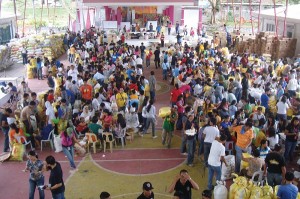Storm victims get $4M in fresh aid
DAVAO CITY—The United States government has given $4 million in additional aid for survivors of Typhoon “Pablo,” according to a top official of an international relief agency.
Stephen Anderson, World Food Programme (WFP) director for the Philippines, said the additional funds from the United States Agency for International Aid (USAID) would benefit at least 170,000 more people in the next two months.
Anderson said the latest funding assistance from USAID would allow WFP to purchase 3.4 million kilograms of rice to feed at least 170,000 people for two months.
Gloria Steele, USAID Philippine mission director, turned over the funding to WFP.
“The additional support will help thousands of affected families recover from the impact of the disaster and enable them to rebuild their lives,” said Anderson in a press conference here.
Article continues after this advertisementHe said WFP has also received the first installment of a P50-million funding aid that allowed WFP to “roll out cash-for-work activities” like debris clearing and livelihood support in Davao Oriental, Compostela Valley and the Caraga region.
Article continues after this advertisementThe International Committee of the Red Cross (ICRC) and the Philippine National Red Cross (PNRC) said they are also continuing efforts to help the typhoon survivors in Southern Mindanao.
Aside from distributing food, the ICRC and PNRC said they are also focusing on providing clean water, shelter, health care and other needs of people in areas devastated by Typhoon Pablo.
In Baganga, Davao Oriental, the ICRC and PNRC have put up a field clinic as government-
operated health facilities there are still not in operation.
“Most of the health facilities in Baganga were either damaged or totally destroyed,” said Dr. Gundula Epp-Graak, who works at the newly established Red Cross Basic Health-care Unit in Baganga.
In his press conference, Anderson admitted that challenges are confronting relief distribution in typhoon-hit areas.
“For the past weeks, the relief operations drew complaints that some affected areas were not reached and affected families have not been served,” he said.
Anderson admitted that “there might be some gaps in the relief operation system,” which led to fewer relief goods for some survivors than others.
This, he said, is a real challenge that relief workers should be able to overcome through a consolidated and united effort. Ayan Mellejor and Allan Nawal, Inquirer Mindanao
